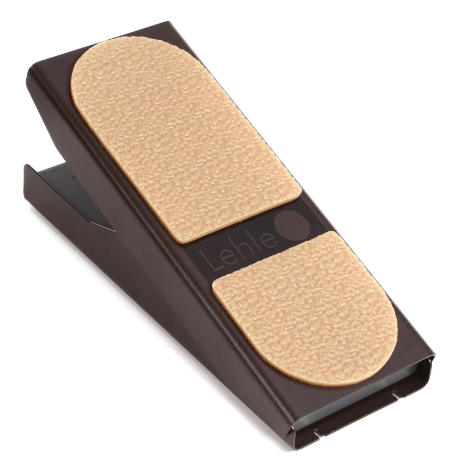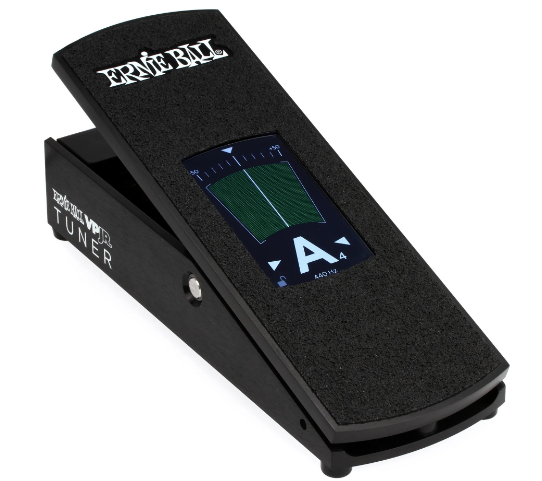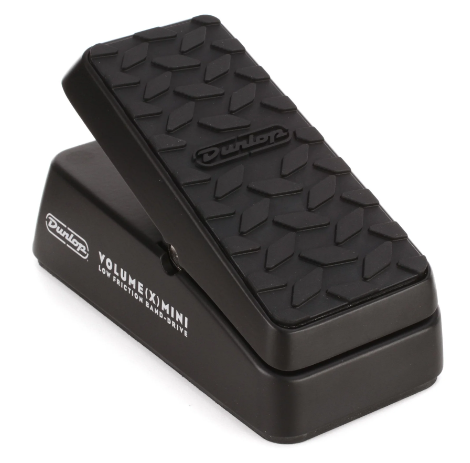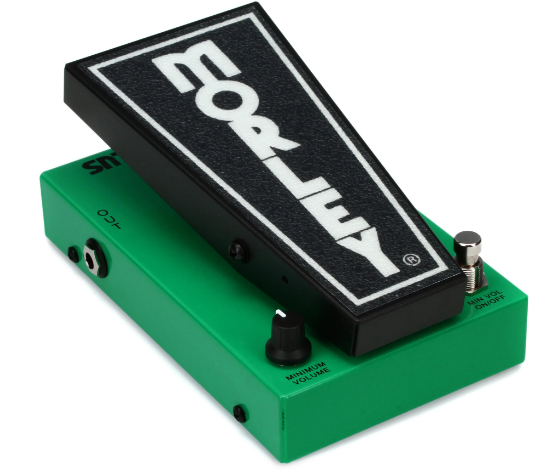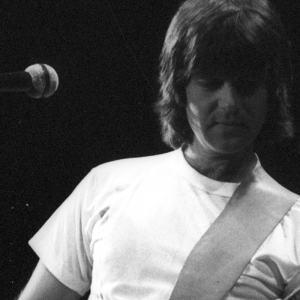Volume or expression pedals are a handy piece of guitar kit, which opens up a range of new creative techniques and playing styles for electric guitarists.
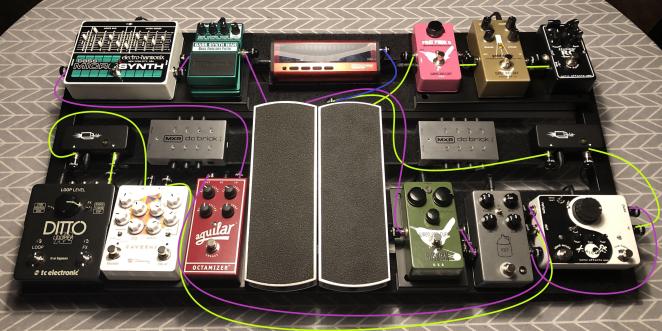
Volume guitar pedals are mostly concerned with one thing – giving the guitarist a way of controlling the volume of their guitar using one foot. While this sounds simple in practice, there is a huge range of methods and situations where they can be used – so you need to make sure you pick the right model.
There are a lot of volume guitar pedals out there, so it can be hard to work out which one will suit your needs. That is why we made this guide – to show you the best guitar volume pedals around and give you some tips on how to choose and use them.
One of my favorite models is the sonuus Voluum. Ok, I know this isn't purely a volume pedal (it's closer to a multi-effects model), but as far as volume pedals go, this one is very exciting. The extra effects (which are linked to the foot position) give you some extra depth and color from this device, which is a great extra bang for your buck.
If you're looking for a pure, pro-volume pedal, look at something like the Lehle Stereo (if you have the cash). And the Ernie Ball 6180 is a classic choice, especially if you're on a budget.
That said, there are a lot of other great choices on this list. Read on for the full lineup and buyer’s guide!
Quick Summary of the Best Volume Pedals for Guitar
- Lehle Stereo Volume Pedal (Best Overall)
- Sonuus Voluum Volume and Multi-effects Pedal (Best Multi-Effect + Volume)
- Ernie Ball VPJR Tuner / Volume Pedal (Best Volume + Tuner)
- Moog EP-3 Universal Polarity Expression Pedal (Budget Beast)
- Dunlop DVP4 Volume (X) Mini Pedal (Small but Mighty)
- Ernie Ball 6180 VP JR 250K Volume Pedal (Passive Workhorse)
- Morley 20/20 Volume Plus Volume Pedal (For Foot Fiddling)
Top 7 Best Volume Pedals Reviewed
Here are the best volume pedals for guitar on the market today. I've included a range of models to cover every end of the budget spectrum – from beginner to pro!
Best Overall
SPECS
- Type - Stereo Active
- Size - Height: 2.6", Width: 3.94", Depth: 10.24"
- Features - Adjustable feel, stereo input and output.
Rock solid, smooth, silent, and versatile: these are all words that describe the Lehle volume pedal range. As far as volume pedals go, I really don't think you'll find anything better (or more expensive) than this. Sure, it's in the pro price range, but this might be the best volume pedal money can buy.
This expression pedal looks simple, but actually packs in a range of features and functions and is full of high-end design. For starters, unlike most volume pedals on this list, the Lehle Stereo is magnetically controlled, rather than using a resistance potentiometer. This means that the interaction is much smoother, and there isn't a single component that will wear out over time, so this pedal will last for decades.
If you're running a stereo guitar effect/amp rig, this pedal is the best choice. It supports stereo input and output, or it can split a mono input into a stereo signal. This gives you a sweet level of versatility and control for more advanced guitar pedal setups.
Another rare feature is the ability to adjust the feel to your preference so you can choose how tight or loose the rotation is, letting you adapt the guitar volume pedal for your performance style.
In terms of feel, durability, and quality, the Lehle Stereo pedal is incredibly hard to beat. The price makes it a very considered purchase, but if you're looking for the very best dedicated volume pedal around, this might be the number 1.
If stereo isn't your thing, this pedal also comes in a mono variation - Lehle Mono Volume Pedal S. This has all the same quality and functionality but works on a single, mono audio signal rather than stereo for about $50 less.
Best Multi-Effect + Volume
This is more than just a volume pedal, this is a fully featured multi-effects pedal, with a built-in volume pedal control!
SPECS
- Type - Mono Active Multi-Effects
- Size - Height: 2.99", Width: 6.73", Depth: 7.56"
- Features - Gate, compressor, tremolo, volume, limiter control, USB,
Ok, this isn't just a volume pedal, so it might be a bit unfair to compare it to other models on this list – although technically, it is a volume pedal (with multi-effects). Also, the pricing comes in at a similar level to premium volume pedals – I love this pedal, so I had to include it.
This volume and expression pedal is full of other features, functions, and effects. It's closer to a multi-effects pedal than a standard volume pedal, but the emphasis isn't so much on the effects like other multi-effects – so I'd call it a multi-effect-volume pedal, rather than one or the other.
Looking at the features of this pedal, you can see that you're clearly getting bang for your buck. Besides the high-quality expression pedal section, it comes with a range of handy effects controlled activated by a true bypass switch, and controlled with the expression pedal.
You get a gate/expander for cleaning up your signal (this is perfect for noisy pedal chain circuits), an LFO for adding some tremolo movement, a compressor (for taming your dynamic range and a limiter for some extra compression.
The strength of most of these effects can be controlled by the foot position of the expression pedal, so you can get even more articulation and expression out of your foot compared to standard popular guitar volume pedals.
This is hands-down one of the most versatile volume pedals out there. If you're looking to bundle in a few extra effects and processes to manage your guitar signal, you're going to love the Sonuss Voluum.
Best Volume + Tuner
As you can see, this volume pedal features a handy built-in tuner - it's no gimmick though, as the pedal itself is super sweet.
SPECS
- Type - Active Tuner Volume Pedal
- Size - Height: 2.5", Width: 3.5", Depth: 10"
- Features - Tuner, FX loop, touchscreen display
Tuner pedals are one of the most commonly used (and important) components in a pedal board setup, so this combination of tuning and foot-based volume control is an appealing offering from Ernie Ball.
They haven't slacked on either element – both the tuner and volume pedal elements are fantastic in their own right, but the combination of the two makes this pedal particularly tempting and valuable. You're basically getting two pro pedals for the price of one; not only saving on cash but also pedalboard space.
In terms of the volume pedal element, the Ernie Ball VPJR is a rugged, articulate, and well-thought-out design. It's made from aircraft-grade aluminum, making it lightweight but tough, and the pedal is a joy to control with your foot.
The tuner element is also very nice – I would say it competes with standalone tuner pedals at the same price as this 2-in-1. It features a touch-screen display interface for editing the tuning parameters, including changing the reference pitches, screen brightness, and other handy configurations. It's super precise, and the display is easy to read on dark screens, so you can quickly get tuned up with no stress.
Another neat feature is the effects loop in/out. This lets you use the pedal as a send/return controller - opening several options in signal flow control and performance. This will be particularly attractive to guitar players who use a lot of other pedals like reverbs, delays, and modulation.
Overall, this pedal is hard to criticize for the price. You're clearly getting two pedals for the price of one, and both the tuner and volume pedal elements are very well-made.
Budget Beast
A cheap but cheerful passive volume pedal, the Moog EP-3 conveniently gets the job done.
SPECS
- Type - Passive mono
- Size - Height: 4", Width: 3.5", Depth: 12"
- Features - Polarity switch, level adjustment
For guitarists looking for their first Volme pedal without breaking the bank, the Moog EP-3 is a strong contender. This is one of the better budget-friendly volume pedals on this list, and while the price is low, it still has a few nice features and decent build quality.
Looking at the features to start, it has a few tricks up its sleeve - namely the polarity switch for changing what type of device it's designed to work with, and a level adjustment for fine-tuning how the motion range affects the gain.
Being a passive pedal, it doesn't require any power supply, so you don't need to worry about batteries or a power cable, which is a nice feature for newer guitarists with basic pedal boards. The build quality is pretty sturdy too, and it feels like it will survive a few years of stomping.
Overall, if you're on the hunt for an affordable and basic volume pedal, the Moog-EP3 will be a trusty companion.
Small but Mighty
This compact volume pedal packs in all the features of their full-sized siblings, but in a smaller and more portable format.
SPECS
- Type - Mini mono passive pedal
- Size - Height: 2.5", Width: 2.97", Depth: 6"
- Features - Aux output, minimum volume control, tiny footprint
This pedal really proves that size isn't everything! The Dunlop DVP4 Mini pedal is a shrunken version of Dunlop's classic volume pedal. It's about 50% the size but packs in 100% of the original features.
If you're running a busy, full pedal board, you might not have room for a full-sized volume pedal – and let's face it, these pedals are usually pretty chunky. That's when something like the DVP4 Mini is a lifesaver.
The neat features include the ability to set the minimum volume, as well as an aux output, essentially splitting your signal chain in two at the pedal. This is often used as a tuner output, where the unprocessed signal is sent directly into a tuning pedal (or other effects).
As you would expect, this is a bit fiddlier to use compared to a full-size pedal – it's going to be smaller than most people's shoes. But it's still accurate enough to use expressively in a performance. The price is also very reasonable.
Passive Workhorse
This passive pedal sits in the sweet spot between budget and quality. It's relatively affordable and offers great value for money.
SPECS
- Type - Passive volume pedal
- Size - Height: 2.4", Width: 3.5", Depth: 10"
- Features - Response tuning, adjusting swell rates
Simple but effective, the Ernie Ball 6180 passive volume pedal does everything you need without any unwanted bells and whistles.
It's a pretty basic pedal, with the only notable feature being the micro taper which lets you adjust how the pedal responds to your foot, and change the swell rates. But the simplicity isn't necessarily a downside. Volume pedals should only really do one function - change the volume of your guitar signal.
This pedal does that job, and it does it well. I think most of your money is going into the sturdy and well-designed case. It's super smooth and comfortable to use, the foot panel is the perfect size and allows for accurate and dynamic expression, and the case is made of rock-solid steel – so you can stomp on this thing pretty hard for years to come.
For Foot Fiddling
SPECS
- Type - Active volume pedal
- Size - Height: 2.75", Width: 4.5", Depth: 6.85"
- Features - Foot-controlled toggle,
This is definitely one of our favorite-looking models on this list, as it takes a lot of inspiration from early guitar effects pedals. Looks aside, this is a nicely built pedal with a handy (or footy?) feature.
For starters, this pedal feels incredibly robust – like you could literally stomp on it at full force and it would be fine (although we're not recommending that you do that). The layout of the foot pedal also makes it a bit easier to balance, without so much side-to-side wobble, where some pedals can feel a little unstable.
The main standout feature is the minimum volume knob and switch, letting you change the lowest volume level of the pedal with the click of a button from your foot. This essentially gives you two control modes that can easily be switched between.
Besides this, the features are a little barebones, but you can tell that the main design budget has been spent on the overall engineering and materials of the pedal. The electro-optical circuitry used for interpreting your foot movement is a lot more accurate and responsive than a basic resistance potentiometer design. It also prevents degradation that creates scratchy pots.
This simple pedal is worth the money if you want something that's going to survive the strain of years of playing and touring.
Volume Pedals Buyer's Guide
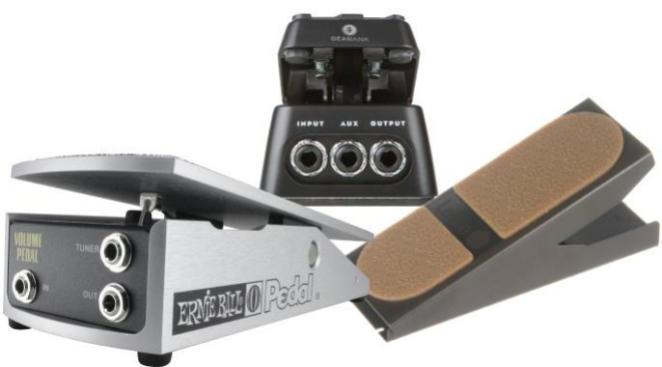
You can find a huge range of volume pedals on the market today, and while they all revolve around the same core function, there is still a fair amount of variety available. This buyer’s guide clears up some of the distinctions and variations you can find across the volume pedal scene.
Active or Passive
One of the first things to consider is whether you want an active or passive pedal. An active volume pedal requires a power source (battery or cable), but is more responsive, and offers a wider range of features. Active volume pedals can also boost the volume, while passives cannot.
Alternatively, a passive volume pedal works simply by using a variable resistor to reduce the volume. While passive pedals can’t boost your tone, they function fine for signal attenuation and are slightly more convenient due to the fact they don’t require any power. Passive volume pedals are a good choice if you want something simple and don't want to worry about managing the power.
Powering
One of the more logistical considerations to make is the powering system for the pedal (if you go for an active one). Guitar pedals that require power are usually powered by batteries and/or cables.
Typically, these use a rectangular 9v battery housed somewhere inside the device, and/or a 9v cable. Some devices use one or the other.
If you already have a few guitar pedals then you should consider getting a pedal that easily integrates with your existing setup style - so make sure it has the same cable connector etc. Batteries are slightly more convenient as you don’t need so many wires on your pedal board, but you do have to deal with batteries going flat and needing to be replaced.
Functionality
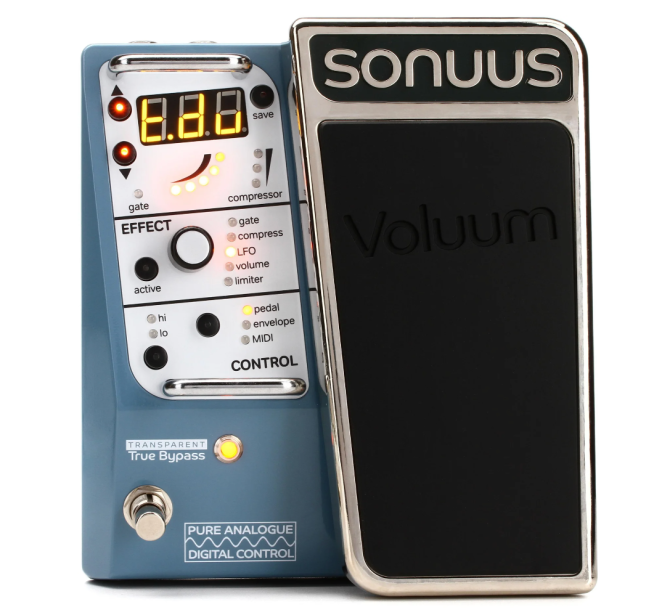
While the core functionality of volume pedals is largely identical (controlling the volume with your foot), there is still a lot of range in extra features and functionality, which you might be interested in.
Some pedals offer depth control. Which can change how wide the pedal's volume control is - giving you a bit more diversity in your performance techniques. You can also find some that allow you to change the curve of the control, which again is useful for fine-tuning the articulation of your pedal interaction.
Some other neat features include boost functionality, where you can engage a bit of extra gain, usually by clicking in the pedal with your toe at the top. Check out some of our picks for the best expression pedals for more options.
Another super cool (but often expensive) feature is the option for a hybrid wah/volume pedal. This essentially gives you two pedals in one, letting you switch the function of the pedal between working as a standard volume pedal or as a wah pedal - letting you filter your guitar with the classic wah sound - you should know what I'm talking about!
Size and Shape (Foot Comfort)
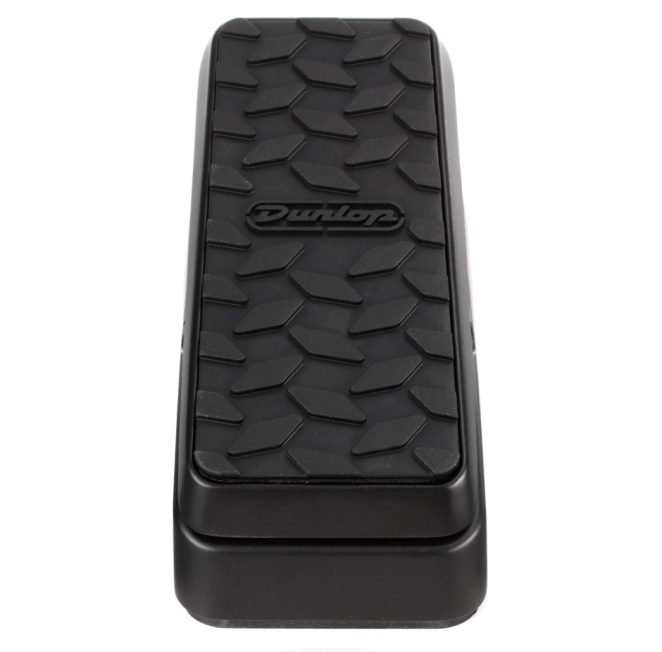
One of the most essential things to think about for this type of pedal is the size, shape, and style. Ultimately you want something that is comfortable for your feet and fits well into your pedalboard.
You can find quite a range of shapes and sizes, so do some research into the models you’re interested in and maybe measure them up against your pedal board.
Find a pedalboard that will fit all the pedals you need on our guide to the best pedalboards.
There is also a fair amount of variation in terms of the hinge strength and angle. This affects how your ankle is used to rotate the pedal, and is important to get right if you plan on using your volume pedal a lot––you want one that fits like a glove (or should I say sock?)
Price: Materials and Quality
Unlike a lot of other guitar pedals, the sonic/tonal variation between volume pedals is a lot lower and less important (unless you are looking at ones with a boost function, in which case the extra gain will have different colors from model to model).
The main effect of price differences in volume pedals is largely related to the build quality and components rather than the audio quality. Cheaper pedals tend to be a bit flimsier or not so smooth to use, even clunky.
More expensive pedals offer higher-quality foot interaction and will be sturdier and longer lasting. If you have the money, it's worth investing in a high-quality, durable pedal, as these can take a lot of abuse over the years - they have to take the weight of your leg and body after all!
FAQs About Volume Guitar Pedals
How useful is a volume pedal?
Volume pedals can be very useful for guitarists (and other electric instrument players). While at face value, they might seem to serve a limited purpose––controlling the volume with your feet––in reality, they are a powerful tool that opens up a range of expressive articulation and playing techniques.
Volume pedals are particularly cool when they’re interacting with other effects pedals. For example, you can use volume pedals to create swell effects when plugged in before reverb and delay pedals. They’re also useful for managing overdrive and gain on multi-channel pedal boards.
Sure, these might not be the best pedal to buy as your first guitar pedal, but they’re a useful addition.
Do I need a volume pedal on my pedalboard?
While volume pedals aren’t always essential for your pedalboard, they are very useful (and if you’re running a larger pedalboard setup, I would say that volume pedals are basically required)!
If you only have 1 or 2 other guitar pedals, a volume pedal might not be that useful, although it’s always handy if you want some hands-free volume control, and the ability to unlock swell and other volume envelope techniques.
However, if you have a lot of guitar pedals, and a complex pedal board setup (maybe with multiple channels of effects) I would say that you really should be using a volume pedal––it opens up many performance techniques, and they’re logistically useful in many situations, like muting your pedals while you switch guitars etc.
And the Winner Is...
You should now have no trouble finding the perfect volume pedal for your pedal board. With the list of my favorite volume pedals above and the handy buyer's guide, you’ll easily be able to find the right choice. Just remember to consider the extra feature, powering system, and shape and size of the pedal so that it integrates nicely with your setup.
Trust me, the quality of life improvements made by a decent volume pedal are not to be underestimated, they open up new techniques, and mean you won’t have to bend over to fiddle with pedals so much. You can get really creative with them!
The Sonuus Voluum is my top recommendation if you'd like a bit of versatility with your new pedal. I really love this pedal because it pushes the boundaries of what volume pedals can do. It shows you how the integration of extra effects can expand the possibilities offered by a volume pedal.
But for something more pure, the Lehle Stereo is about as nice of a volume pedal as you can buy, and the classic Ernie Ball 6180 is a solid workhorse if you're on a tighter budget.
